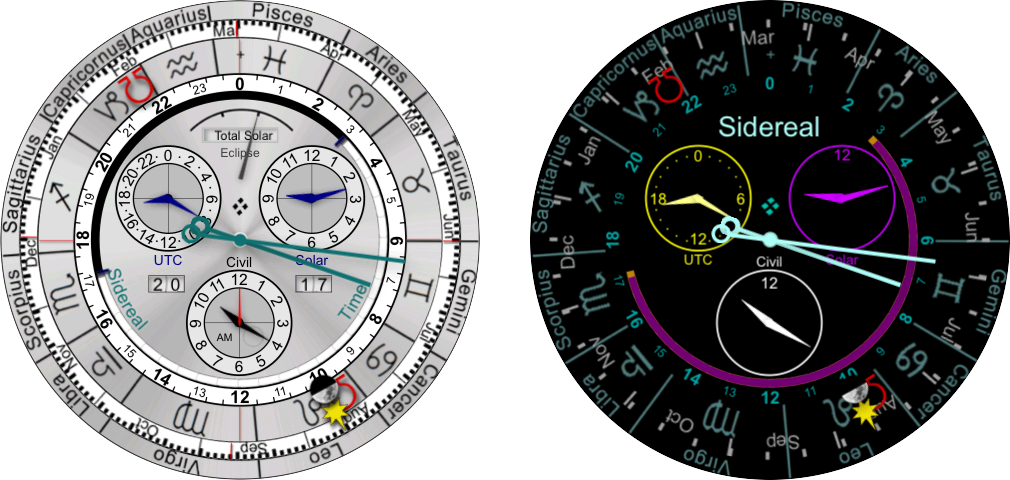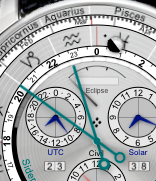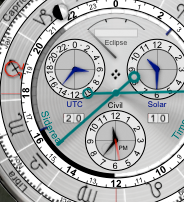
| Buy this face |

|
| Buy all 21 faces |

|

| Buy this face |

|
| Buy all 21 faces |

|
Basel takes its name from the city in Switzerland , home to the world's largest watch show.
On Basel, there are 16 hands
plus 12 additional indicators.
, home to the world's largest watch show.
On Basel, there are 16 hands
plus 12 additional indicators.
 The primary hands show the
local apparent sidereal time
The primary hands show the
local apparent sidereal time .
The hour is read against the inner white dial of 24 numbers (hours of
right ascension
.
The hour is read against the inner white dial of 24 numbers (hours of
right ascension , RA),
the minutes against the 60 unnumbered tick marks (minutes) on that dial.
, RA),
the minutes against the 60 unnumbered tick marks (minutes) on that dial.
The precession of the equinoxes means that the position of the equinox moves with respect to the fixed stars.
But the zero point of right ascension is the vernal equinox. (Equinox, in this context, means the intersection of the
ecliptic plane and the Earth's equator, named because the apparent path of the Sun crosses that point at the time of
the equinox).
means that the position of the equinox moves with respect to the fixed stars.
But the zero point of right ascension is the vernal equinox. (Equinox, in this context, means the intersection of the
ecliptic plane and the Earth's equator, named because the apparent path of the Sun crosses that point at the time of
the equinox).
 So since Basel's RA dial is fixed, the
rings holding the names and astrological symbols of the constellations of the zodiac rotate slowly
to compensate for the precession.
The lines between the constellations indicate the points where the ecliptic crosses the constellation boundaries (for the present era).
The sidereal hour hand thus indicates which constellation is currently highest in the sky.
(The minute hand has no relation to the constellations.)
In this example, the sidereal time is 22:51 in Aquarius in the year 2338 CE.
So since Basel's RA dial is fixed, the
rings holding the names and astrological symbols of the constellations of the zodiac rotate slowly
to compensate for the precession.
The lines between the constellations indicate the points where the ecliptic crosses the constellation boundaries (for the present era).
The sidereal hour hand thus indicates which constellation is currently highest in the sky.
(The minute hand has no relation to the constellations.)
In this example, the sidereal time is 22:51 in Aquarius in the year 2338 CE.
The outer white ring is divided into the months of the year with
a hairline at the beginning of each month and
tick marks for every other day; the black tick marks
represent even days of the month, and the spaces between represent odd days.
 It, too, rotates with respect to the RA dial
so that the Sun hand indicates the current date.
(May 9 in this example.)
But note that the relationship between the date ring and the zodiac
ring is correct only at the position of the Sun hand, for two reasons:
Because the Earth's orbit is elliptical (not an exact circle),
the Sun moves more slowly against the stars at some times during the year than at others.
Also, the Sun's motion is in the ecliptic plane
which is tilted with respect to the reference plane of the RA coordinate system
(the equator). So the Sun does not
move at a constant rate around the RA dial during the year, but speeds up and slows
down at intervals.
The date ring rotates so that the current date is always under the Sun,
but that means that other dates are in slightly different spots when the Sun gets there.
It, too, rotates with respect to the RA dial
so that the Sun hand indicates the current date.
(May 9 in this example.)
But note that the relationship between the date ring and the zodiac
ring is correct only at the position of the Sun hand, for two reasons:
Because the Earth's orbit is elliptical (not an exact circle),
the Sun moves more slowly against the stars at some times during the year than at others.
Also, the Sun's motion is in the ecliptic plane
which is tilted with respect to the reference plane of the RA coordinate system
(the equator). So the Sun does not
move at a constant rate around the RA dial during the year, but speeds up and slows
down at intervals.
The date ring rotates so that the current date is always under the Sun,
but that means that other dates are in slightly different spots when the Sun gets there.
There are red hairline indicators over the zodiac ring (fixed at 0, 6, 12, and 18) which mark the positions of the equinoxes and solstices, and a plus sign between Aquarius and Pisces on the zodiac ring which marks the RA position of the vernal equinox in the year 2000. There are four smaller red hairline indicators over the date ring which move slowly to indicate the dates of the equinoxes and solstices. They stay close to the fixed indicators but they don't always line up exactly because as mentioned above the date ring does not match the zodiac ring except exactly at the Sun's position.
The Sun and Moon hands show their positions with respect to the the RA dial
and the constellations (and each other).
The red Ω-shaped hands show the positions of the
lunar ascending and descending nodes (the ascending node indicator has the Ω rightside-up at 12 o'clock).
(the ascending node indicator has the Ω rightside-up at 12 o'clock).
 When the Sun and Moon coincide and are close to one of the nodes it is possible that there may be a solar eclipse;
when the Sun is close to one node and the Moon is opposite to it a lunar eclipse may occur.
When the Sun and Moon coincide and are close to one of the nodes it is possible that there may be a solar eclipse;
when the Sun is close to one node and the Moon is opposite to it a lunar eclipse may occur.
The eclipse dial
 at the top center indicates if there is an eclipse happening at the observer's location and time.
at the top center indicates if there is an eclipse happening at the observer's location and time.
Also, note that when the ascending-node hand coincides with the vernal equinox
 (at the 12 o'clock position)
the Moon will reach extremes in several dimensions, including north and south declination,
northern and southern azimuths of rise/set points on the horizon, and altitudes crossing the meridian.
See here
(at the 12 o'clock position)
the Moon will reach extremes in several dimensions, including north and south declination,
northern and southern azimuths of rise/set points on the horizon, and altitudes crossing the meridian.
See here for more detail.
for more detail.
The subdial at 2 o'clock shows
apparent solar time (sundial time) in 12-hour format.
(Note that the Sun hand and the sidereal hour hand will always coincide when the solar time is 12:00.)
(sundial time) in 12-hour format.
(Note that the Sun hand and the sidereal hour hand will always coincide when the solar time is 12:00.)
The subdial at 10 o'clock shows UTC in 24-hour format.
The subdial at 6 o'clock shows ordinary clock time with seconds and an AM/PM indicator.
The left window (beneath the UTC subdial) shows the first two digits of the year number (centuries), the right window (beneath the Solar subdial) shows the last two digits.
 Finally, just inside the RA dial is a ring which shows the sidereal times
when the Sun and Moon illuminate the sky for this day.
The white region is bounded by sunrise and sunset and thus shows the daytime hours (in sidereal time).
The dark regions represent nighttime with gray when the Moon is up and black for full night.
There are also two tiny hands that indicate the (sidereal) times of moonrise and moonset.
In this example, it is about an hour before moonrise (as indicated by the sidereal hour hand), moonset is a bit before 3, and Libra is near the meridian.
Finally, just inside the RA dial is a ring which shows the sidereal times
when the Sun and Moon illuminate the sky for this day.
The white region is bounded by sunrise and sunset and thus shows the daytime hours (in sidereal time).
The dark regions represent nighttime with gray when the Moon is up and black for full night.
There are also two tiny hands that indicate the (sidereal) times of moonrise and moonset.
In this example, it is about an hour before moonrise (as indicated by the sidereal hour hand), moonset is a bit before 3, and Libra is near the meridian.
In ambient mode, the primary displays remain (in other colors to save energy), but some minor displays and hands (such as the eclipse indicator) are omitted.